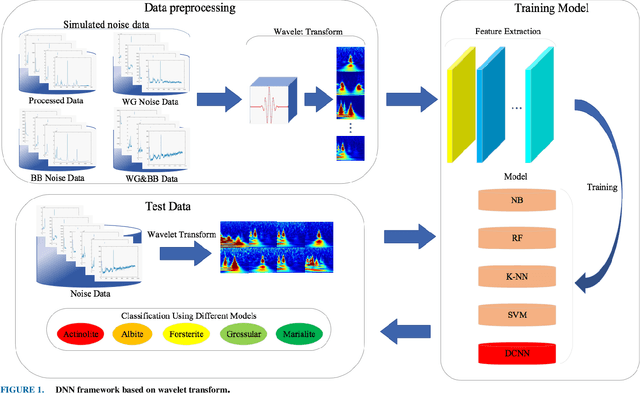Sittiporn Channumsin
Method for classifying a noisy Raman spectrum based on a wavelet transform and a deep neural network
Sep 09, 2020



Abstract:This paper proposes a new framework based on a wavelet transform and deep neural network for identifying noisy Raman spectrum since, in practice, it is relatively difficult to classify the spectrum under baseline noise and additive white Gaussian noise environments. The framework consists of two main engines. Wavelet transform is proposed as the framework front-end for transforming 1-D noise Raman spectrum to two-dimensional data. This two-dimensional data will be fed to the framework back-end which is a classifier. The optimum classifier is chosen by implementing several traditional machine learning (ML) and deep learning (DL) algorithms, and then we investigated their classification accuracy and robustness performances. The four MLs we choose included a Naive Bayes (NB), a Support Vector Machine (SVM), a Random Forest (RF) and a K-Nearest Neighbor (KNN) where a deep convolution neural network (DCNN) was chosen for a DL classifier. Noise-free, Gaussian noise, baseline noise, and mixed-noise Raman spectrums were applied to train and validate the ML and DCNN models. The optimum back-end classifier was obtained by testing the ML and DCNN models with several noisy Raman spectrums (10-30 dB noise power). Based on the simulation, the accuracy of the DCNN classifier is 9% higher than the NB classifier, 3.5% higher than the RF classifier, 1% higher than the KNN classifier, and 0.5% higher than the SVM classifier. In terms of robustness to the mixed noise scenarios, the framework with DCNN back-end showed superior performance than the other ML back-ends. The DCNN back-end achieved 90% accuracy at 3 dB SNR while NB, SVM, RF, and K-NN back-ends required 27 dB, 22 dB, 27 dB, and 23 dB SNR, respectively. In addition, in the low-noise test data set, the F-measure score of the DCNN back-end exceeded 99.1% while the F-measure scores of the other ML engines were below 98.7%.
 Add to Chrome
Add to Chrome Add to Firefox
Add to Firefox Add to Edge
Add to Edge